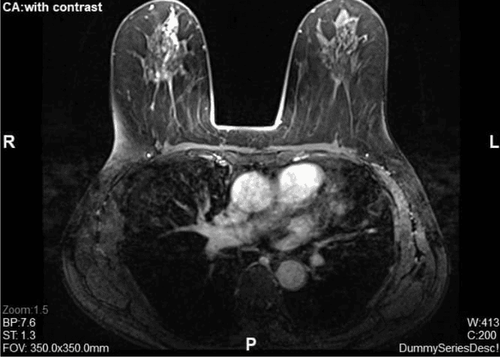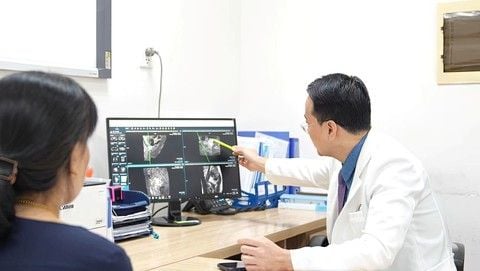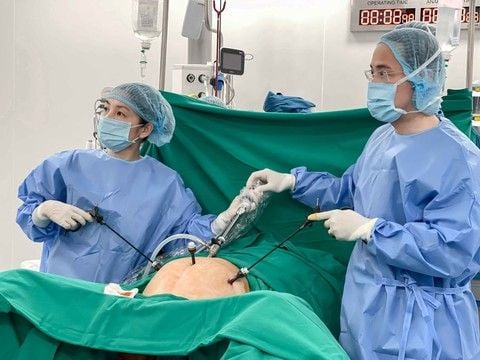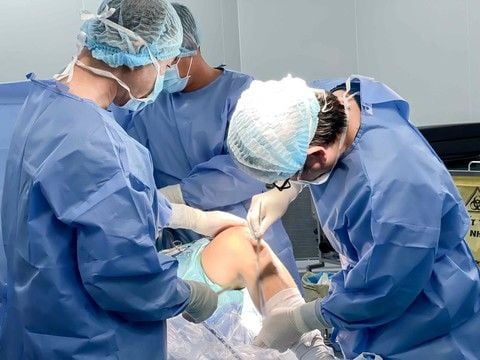A female patient (69 years old) had symptoms of pain and bloody discharge from the right nipple, accompanied by a mild fever. Initially, the patient visited another hospital and was diagnosed with right mastitis (inflammation of the breast), then treated for this disease. Although the treatment helped relieve the pain, the nipple discharged spontaneously, with no specific cause. Worried about her health, the patient decided to go to the Breast Center, Vinmec Times City International Hospital after being introduced by an acquaintance.
Upon arriving at the Breast Center, Vinmec Times City International Hospital, the patient was assigned to perform tests to determine the cause of nipple discharge. The diagnostic steps include:
- Ultrasound and breast X-ray: Results did not detect obvious lesions.
- Magnetic resonance imaging (MRI): The image recorded non-mass contrast enhancement in the right breast, classified as BI-RADS 4, indicating a risk of malignancy, so caution is needed.
- Nipple fluid test: Group III cytology test results, showing atypical cells.
This patient's case posed a great challenge to doctors at Vinmec, because the initial diagnostic images did not clearly show lesions. To provide accurate results, doctors at the Breast Center utilized modern techniques such as MRI 3.0T and second-look ultrasound (searching for lesions not detected the first time) to precisely determine the location of the biopsy. Next, the team of doctors decided to perform a biopsy, and place a marker to mark the lesion in the right breast. The final results determined that the patient had ductal carcinoma in situ - a type of breast cancer that is still localized within the duct and has not yet invaded surrounding tissue. This is an important discovery, giving the patient the opportunity to receive early treatment, when the cancer is still in its early stages. Combined with advanced imaging techniques and deep expertise, the doctors were successful in diagnosing ductal carcinoma in situ for the patient, giving her the opportunity to receive timely treatment and avoid the risk of worsening.

The above case is a warning that nipple discharge can be a sign of some benign conditions such as mastitis or more dangerous diseases such as breast carcinoma. To be able to detect early and treat promptly, doctors recommend that patients should see a doctor when any unusual symptoms appear in the breast, especially nipple discharge accompanied by signs such as:
- Abnormal discharge: If the discharge from the nipple has an unusual color such as blood, yellow or milky color that is not related to pregnancy.
- Prolonged and spontaneous discharge: Spontaneous nipple discharge, not caused by force and lasting for many days.
- Appearing in a duct: Discharge from a duct without any cause.
- Discharge on only one breast: Discharge on only one breast instead of both.
- Accompanying tumor: If the discharge is accompanied by a tumor when touched, the patient needs to immediately perform examination steps for diagnosis and treatment.
Although nipple discharge is not always a sign of a serious illness, the patient should be cautious. In many cases, early detection will help increase the effectiveness of treatment and improve the patient's quality of life, minimizing adverse effects on health. In particular, with ductal carcinoma in situ as in the case of the patient above, if detected early, the possibility of successful treatment is very high and the patient can avoid many dangerous complications.
The Breast Center at Vinmec Times City International Hospital is one of the units applying the most advanced technologies in diagnosing and treating breast diseases. By using a modern MRI 3.0 T system, highly accurate biopsy techniques, especially a multidisciplinary coordination process, the Breast Center, Vinmec Times City International Hospital has supported thousands of patients to detect and effectively treat breast diseases at an early stage, helping to protect the health and quality of life for women.
To arrange an appointment, please call HOTLINE or make your reservation directly HERE. You may also download the MyVinmec app to schedule appointments faster and manage your reservations more conveniently.


